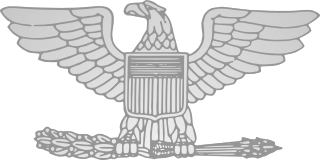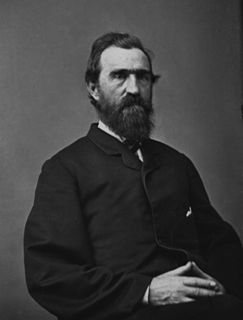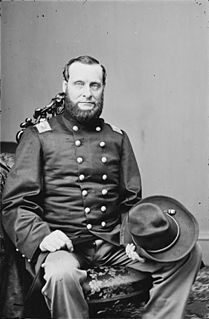Service
The 3rd Kentucky Infantry was organized at Camp Dick Robinson and mustered in for a three-year enlistment on October 8, 1861, under the command of Colonel Thomas Elliott Bramlette.

In mid-May 1861, U. S. Navy lieutenant William "Bull" Nelson armed Kentuckians loyal to the Union and that soon became the foundation for his receiving authority to enlist 10,000 troops for a campaign into East Tennessee. On August 6, 1861, those recruits marched into Camp Dick Robinson, making it the first Federal base south of the Ohio River. For Col. George C. Kniffen, "the wisdom of President Lincoln commissioning. .. Nelson to organize a military force on the [neutral] soil of Kentucky" prevented making the state a "battle ground for many months" and it thereby changed the whole direction of the war. In 1864, Salmon P. Chase declared in a speech at Louisville "when Kentucky faltered, hesitated" in the early stages of the Civil War, that undecided "status was settled by WILLIAM NELSON, at Camp Dick Robinson." Six years later, Indiana Senator Daniel D. Pratt reported to the U. S. Senate that Camp Dick Robinson "was one of the most noted military encampments of the war.. .. From its admirable locality and advantages, it was almost indispensable for the successful operations of the" Civil War.

In the United States Army, Marine Corps, and Air Force, colonel is the most senior field grade military officer rank, immediately above the rank of lieutenant colonel and immediately below the rank of brigadier general. It is equivalent to the naval rank of captain in the other uniformed services. The pay grade for colonel is O-6.

Thomas Elliott Bramlette was the 23rd Governor of Kentucky. He was elected in 1863 and guided the state through the latter part of the Civil War and the beginning of Reconstruction. At the outbreak of the war, Bramlette put his promising political career on hold and enlisted in the Union Army, raising and commanding the 3rd Kentucky Infantry. In 1862, President Abraham Lincoln appointed him district attorney for Kentucky. A year later, he was the Union Democrats' nominee for governor. Election interference by the Union Army gave him a landslide victory over his opponent, Charles A. Wickliffe. Within a year, however, federal policies such as recruiting Kentucky Negroes for the Union Army and suspending the writ of habeas corpus for Kentucky citizens caused Bramlette to abandon his support of the Lincoln administration and declare that he would "bloodily baptize the state into the Confederacy".
The regiment was attached to Thomas' Command to November 1861. 11th Brigade, Army of the Ohio, to December 1861. Unattached, London, Kentucky, Army of the Ohio, to March 1862. 15th Brigade, 4th Division, Army of the Ohio, March 1862. 20th Brigade, 6th Division, Army of the Ohio, March 1862. 15th Brigade, 6th Division, Army of the Ohio, to September 1862. 15th Brigade, 6th Division, II Corps, Army of the Ohio, to November 1862. 1st Brigade, 1st Division, Left Wing, XIV Corps, Army of the Cumberland, to January 1863. 1st Brigade, 1st Division, XXI Corps, Army of the Cumberland, to April 1863. 3rd Brigade, 1st Division, XXI Corps, to October 1863. 3rd Brigade, 2nd Division, IV Corps, to January 1865.
The Army of the Ohio was the name of two Union armies in the American Civil War. The first army became the Army of the Cumberland and the second army was created in 1863.

There were five corps in the Union Army designated as II Corps during the American Civil War. These formations were the Army of the Cumberland II Corps commanded by Thomas L. Crittenden from October 24, 1862, to November 5, 1862, later renumbered XXI Corps; the Army of the Mississippi II corps led by William T. Sherman from January 4, 1863, to January 12, 1863, renumbered XV Corps; Army of the Ohio II Corps commanded by Thomas L. Crittenden from September 29, 1862, to October 24, 1862, transferred to Army of the Cumberland; Army of Virginia II Corps led by Nathaniel P. Banks from June 26, 1862, to September 4, 1862, and Alpheus S. Williams from September 4, 1862, to September 12, 1862, renumbered XII Corps; and the Army of the Potomac II Corps from March 13, 1862, to June 28, 1865.

XIV Corps was a corps of the Union Army during the American Civil War. It was one of the earliest corps formations in the Western Theater of the American Civil War.
The 3rd Kentucky Infantry mustered out of service at Louisville, Kentucky, by company beginning October 13, 1864, and ending January 10, 1865.

Louisville is the largest city in the Commonwealth of Kentucky and the 29th most-populous city in the United States. It is one of two cities in Kentucky designated as first-class, the other being Lexington, the state's second-largest city. Louisville is the historical seat and, since 2003, the nominal seat of Jefferson County, located in the state's north and on the border with Indiana.
Detailed service
Moved to Lexington, Ky., September 1861, and duty there until October 1. Moved to Camp Dick Robinson, Ky., October 1. Duty there, at Round Stone Creek, Crab Orchard, Somerset and Columbia until January, 1862. Moved to Renick's Creek, near Burkesville, January 7, and to mouth of Greasy Creek January 17. Moved to Nashville, Tenn., March 18–25; thence march to Savannah, Tenn., and to Shiloh March 29-April 7. Advance on and siege of Corinth, Miss., April 29-May 30. Pursuit to Booneville May 30-June 6. Buell's Campaign in northern Alabama and middle Tennessee June to August. March to Nashville, Tenn., and Louisville, Ky., in pursuit of Bragg, August 19-September 26. Pursuit of Bragg into Kentucky October 1–18. Battle of Perryville October 8. Nelson's Cross Roads, Ky., October 18. March to Nashville, Tenn., October 18-November 7, and duty there until December 26. Advance on Murfreesboro December 26–30. Stewart's Creek December 29. Battle of Stones River December 30–31, 1862 and January 1–3, 1863. Duty at Murfreesboro until June. Reconnaissance to Nolensville and Versailles January 13–15. Tullahoma Campaign June 23-July 7. Occupation of middle Tennessee until August 16. Passage of Cumberland Mountains and Tennessee River and Chickamauga Campaign August 16-September 22. Reconnaissance toward Chattanooga September 7. Lookout Valley September 7–8. Occupation of Chattanooga September 9. Lee and Gordon's Mills September 11–13. Near Lafayette September 14. Battle of Chickamauga September 19–20. Siege of Chattanooga September 24-October 26 Reopening Tennessee River October 26–29. Chattanooga-Ringgold Campaign November 23–27. Orchard Knob November 23–24. Missionary Ridge November 25. Pursuit to Graysville November 26–27. March to relief of Knoxville November 28-December 8. Campaign in eastern Tennessee until April 1864. March to Charleston April 18–26. Atlanta Campaign May to September. Demonstrations on Rocky Faced Ridge and Dalton May 5–13. Tunnel Hill May 6–7. Buzzard's Roost Gap May 8–9. Rocky Faced Ridge May 8–11. Battle of Resaca May 14–15. Near Calhoun May 16. Adairsville May 17. Near Kingston May 18–19. Near Cassville May 19. Advance on Dallas May 22–25. Operations on line of Pumpkin Vine Creek and battles about Dallas, New Hope Church and Allatoona Hills May 25-June 5. Operations about Marietta and against Kennesaw Mountain June 10-July 2. Pine Hill June 11–14. Lost Mountain June 15–17. Assault on Kennesaw June 27. Ruff's Station, Smyrna Camp Ground, July 4. Chattahoochie River July 5–17. Buckhead, Nancy's Creek, July 18. Peachtree Creek July 19–20. Siege of Atlanta July 22-August 25. Flank movement on Jonesboro August 25–30. Battle of Jonesboro August 31-September 1. Lovejoy's Station September 2–6. Moved to Nashville, Tenn., September 9–12; thence to Louisville, Ky., October 6.
This page is based on this
Wikipedia article Text is available under the
CC BY-SA 4.0 license; additional terms may apply.
Images, videos and audio are available under their respective licenses.















